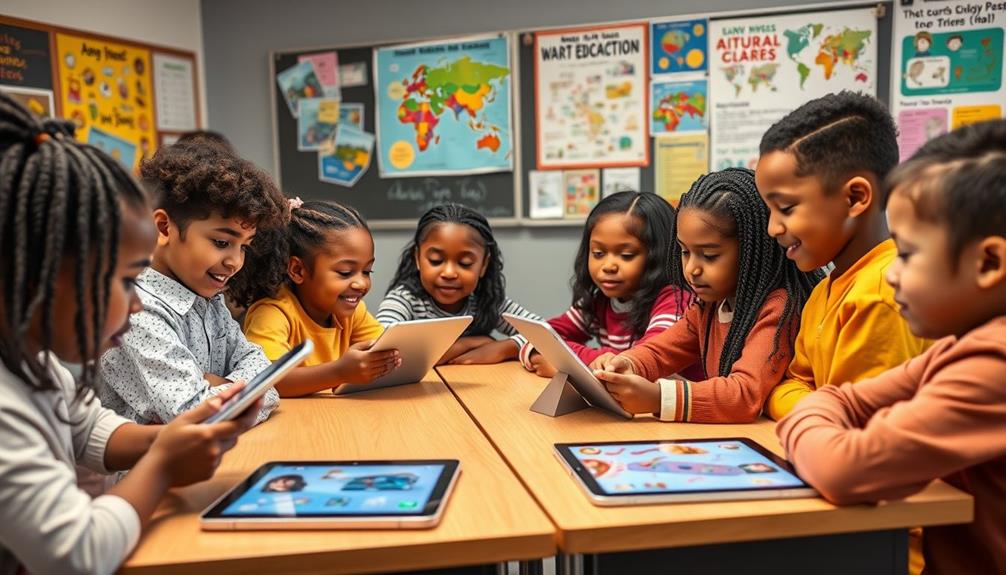AI's revolutionizing education by tackling inequalities head-on. You'll find it personalizes learning, adapting to each student's unique needs. It also uncovers data insights, pinpointing where support's needed most, like with students from low-income backgrounds. AI enhances communication through tools that break language barriers, making sure every voice is heard in the classroom. Plus, it helps identify learning difficulties early, allowing teachers to intervene sooner. By addressing the digital divide, AI improves access to essential technology. If you're curious about how these advancements shape future education, there's much more to explore.
Key Takeaways
- AI personalizes learning experiences, adapting content to meet the diverse needs of marginalized students for improved academic outcomes.
- Early detection tools powered by AI facilitate timely interventions for learning difficulties, enhancing support for at-risk students.
- NLP enhances communication in multilingual classrooms, providing real-time translations and accessibility features for students with diverse language needs.
- Automated data collection through AI streamlines performance tracking, enabling educators to identify disparities and allocate resources effectively.
- AI-driven insights help address the digital divide by providing equitable access to educational resources for low-income and underrepresented communities.
Definition of Educational Inequities
Educational inequities stem from systematic differences in outcomes that affect students' academic success and graduation rates. These inequities are often linked to socio-economic factors that create barriers for marginalized student populations. One major issue is unequal access to resources, such as well-trained teaching staff, high-quality curriculum, and necessary technology. When students don't have these essential tools, their academic achievement suffers.
Additionally, hydration is vital for maintaining cognitive functions, and this can be particularly challenging in underfunded schools where access to basic necessities is limited.
Furthermore, the misalignment between school systems and the diverse needs of students exacerbates educational inequities. This disconnect leads to lower performance, particularly among underrepresented groups who may already face disadvantages. Disparate funding levels further widen the gap; schools serving low-income communities often lack the financial support that their peers receive, resulting in significant performance gaps.
For instance, during the pandemic, nearly 1 in 5 children who were home-schooled lacked appropriate devices, underscoring how access issues can undermine their potential. This situation perpetuates systemic inequality, making it vital to address the root causes of educational inequities.
AI's Potential in Education

AI holds immense potential to transform education by personalizing learning experiences for each student. By leveraging AI, you can create an inclusive environment that addresses the diverse needs of learners, especially those from low-income or marginalized backgrounds.
As the field of education evolves with technology, ethical considerations in data mining must be taken into account to guarantee equitable access and privacy.
Here are four key areas where AI can make a difference:
- Personalized Learning: AI adapts educational content to fit individual learning styles, guaranteeing that all students can thrive.
- Data-Driven Insights: AI tools automate data collection and analysis, helping educators identify disparities and implement targeted interventions.
- Enhanced Communication: Utilizing Natural Language Processing (NLP), AI improves accessibility and engagement in multilingual classrooms, bridging language barriers.
- Proactive Support: AI enables early detection of learning difficulties, allowing you to adjust teaching strategies and provide necessary support to close educational gaps.
Benefits of AI in Learning

AI brings a host of benefits to your learning experience, particularly through personalized learning tailored to your needs.
This approach mirrors the principles of play's importance, where individualized engagement fosters growth and development.
It enhances accessibility for everyone, ensuring that no one gets left behind.
Plus, with early detection tools, educators can quickly identify and address any learning gaps you might face.
Personalized Learning Experiences
Personalized learning experiences revolutionize how students engage with educational content, tailoring it to fit their unique needs and abilities. With AI technologies in education, you can expect a learning journey that's both effective and engaging. Here are some key benefits:
- Adaptive Learning: AI adjusts educational content in real-time based on your individual student performance, ensuring you tackle challenges at your own pace. This data-driven decision-making enhances the learning process by continuously optimizing educational strategies.
- Closing Learning Gaps: By identifying learning gaps early, AI enables educators to proactively adjust teaching strategies, offering targeted support to those who need it most. Such tailored approaches can lead to significant improvements in student engagement and achievement.
- Real-Time Feedback: AI tools provide instant feedback, helping you understand where you excel and where you might need more practice, reinforcing your grasp of the material. This immediate response fosters a more interactive and supportive learning environment.
- Access to AI Tools: With the right access to AI tools, even low-income and marginalized students can receive personalized learning experiences that help close achievement gaps.
These advancements not only foster a deeper understanding of educational content but also create a more inclusive learning environment, allowing every student to thrive.
Embracing personalized learning through AI can truly transform your educational experience.
Enhanced Accessibility Features
Education's evolving landscape is increasingly focused on inclusivity, and enhanced accessibility features are at the forefront of this transformation. AI technology plays a pivotal role in breaking down educational barriers for students with disabilities.
With real-time assistance, it tailors personalized learning experiences to meet individual needs, guaranteeing that everyone has equal access to education. Furthermore, the integration of AI-driven threat intelligence guarantees that educational platforms maintain a secure environment, protecting sensitive student information.
Natural Language Processing (NLP) capabilities enable AI systems to generate subtitles and transcriptions, enhancing communication for diverse learners in multilingual classrooms. This boosts digital literacy, allowing students to engage more fully with their content.
Additionally, AI applications can identify knowledge gaps without bias, helping you adjust your teaching strategies and resources to better support students who may be struggling.
Early Detection Tools
Recognizing and addressing learning difficulties early can make a considerable difference in a student's educational journey.
Early detection tools powered by AI are transforming how educators support students by identifying subtle cognitive differences. These tools enable you to tailor your teaching strategies to meet individual student needs, effectively closing educational gaps.
Additionally, just as the right dog training methods can lead to improved behavior in pets, early intervention can lead to better outcomes for students facing challenges.
Here are some key benefits of AI early detection tools:
- Timely Intervention: By analyzing data, AI tools can flag potential learning issues before they escalate.
- Customized Support: Educators can adapt their approaches based on real-time insights, ensuring learning strategies align with individual student needs.
- Enhanced Learning Outcomes: Research shows that students with special educational needs benefit considerably from early detection, leading to improved academic performance.
- Increased Accessibility: AI tools help remove language and disability barriers, promoting equitable education for all students.
Automating Data Collection

Automating data collection revolutionizes the way educational institutions track and analyze student performance. With AI, you can streamline data collection processes, allowing for faster and more efficient analysis. This is particularly beneficial in resource-limited districts, where timely insights can help address educational inequalities.
By pooling global student data, AI uncovers extensive insights into socioeconomic gaps, enabling policymakers to create targeted interventions. Additionally, the implementation of AI training jobs can help equip educators with the necessary skills to leverage these technologies effectively.
Automated data analysis helps you identify trends and disparities among different student populations, so you can adjust curricula and teaching strategies to meet diverse needs effectively. Real-time tracking of student progress means that you can facilitate timely interventions for those who are struggling, ultimately improving educational outcomes.
Moreover, implementing AI for data collection allows educational institutions to manage and utilize data more efficiently. This leads to informed decisions regarding resource allocation, ensuring that support reaches the students who need it most.
Enhancing Communication With NLP

Natural Language Processing (NLP) transforms how you communicate in educational settings, making language more accessible for everyone.
It not only identifies biases in communication but also supports multilingual classrooms by providing instant translations.
As educational institutions increasingly focus on wellness and health-oriented experiences, NLP can also enhance emotional intelligence by recognizing and addressing students' emotional needs.
With NLP, you can guarantee that every student's voice is heard and valued, fostering a more inclusive learning environment.
Language Accessibility Improvements
Enhancing communication through Natural Language Processing (NLP) is revolutionizing language accessibility in education. By leveraging NLP technology, you can create a more inclusive environment for all students, regardless of their linguistic backgrounds.
For instance, studies suggest that clear communication can greatly reduce anxiety in learners, similar to how cats may exhibit signs of anxiety when separated from their owners.
Here are some key ways NLP improves language accessibility:
- Real-time Subtitles: NLP tools generate immediate subtitles and transcriptions, aiding students with hearing impairments and diverse learning needs.
- Language Translation: NLP facilitates understanding in multilingual classrooms, ensuring every student engages with the curriculum effectively.
- Analyzing Feedback: By evaluating student feedback and performance data, NLP helps educators refine their teaching strategies, enhancing the learning experience for everyone.
- Capturing Communication: NLP improves classroom discussions by accurately capturing and conveying key points, ensuring that all learners grasp essential concepts.
These advancements not only support inclusivity but also empower students to participate actively in their education.
With NLP, you're not just addressing language barriers; you're fostering a richer, more equitable learning environment where every student can thrive.
Bias-Free Communication Analysis
Effective communication is essential for fostering an inclusive educational environment, and NLP offers powerful tools to analyze and improve this aspect. By harnessing natural language processing, you can address communication gaps that often arise in diverse classrooms. This technology promotes inclusivity by guaranteeing that all students, regardless of their linguistic backgrounds, can engage meaningfully.
| NLP Tools | Benefits | Educational Contexts |
|---|---|---|
| Real-time Subtitles | Enhances accessibility | Supports students with hearing impairments |
| Interaction Analysis | Provides personalized feedback | Tailors learning experiences |
| Language Detection | Identifies knowledge gaps | Improves overall engagement |
With NLP applications, you can generate real-time subtitles and transcriptions, which makes learning accessible for non-native speakers. Additionally, analyzing student interactions allows you to detect knowledge gaps and deliver personalized feedback, enhancing the learning experience. These tools guarantee that important information is captured accurately, promoting clearer understanding and retention across all student demographics. Embracing NLP in educational contexts leads to a more equitable environment where every learner can thrive.
Multilingual Classroom Support
Maneuvering a multilingual classroom can be challenging, but NLP tools offer solutions that simplify communication among diverse learners.
With AI in education, these tools foster inclusivity and enhance accessibility, breaking down communication barriers that often hinder academic performance.
Additionally, just as vegan cooking and substitutions allow for tailored dietary needs, NLP tools can be customized to meet the linguistic requirements of each student.
Here's how NLP can support multilingual classrooms:
- Real-Time Translations: NLP tools can provide instant translations, ensuring all students understand lessons and instructions.
- Transcriptions: By generating transcriptions of spoken content, these tools help students who may struggle with listening comprehension.
- Tailored Language Support: Educators can use NLP to customize feedback, addressing individual students' needs and boosting their confidence in language use.
- Engagement Improvement: NLP enhances interactions, encouraging participation and collaboration among students from different linguistic backgrounds.
Early Detection of Learning Issues

By harnessing AI technologies, educators can swiftly identify learning difficulties that might otherwise go unnoticed. Early detection is vital for addressing student performance issues before they escalate. AI systems analyze vast amounts of data, highlighting subtle cognitive differences that traditional assessments often miss. This proactive approach allows you to intervene early, providing timely support to at-risk learners.
With AI's ability to detect these learning difficulties, you can close educational gaps, especially for marginalized students who may lack adequate support in conventional settings. The insights gained from data analysis enable you to understand learning patterns and adjust your instructional methods accordingly.
For instance, if a student struggles with specific concepts, you can modify your teaching strategies to better meet their needs.
Moreover, this early detection lays the groundwork for personalized learning experiences, allowing students to progress at their own pace. By addressing individual needs promptly, you reduce the risk of students falling behind, ensuring that every learner has the opportunity to succeed.
Ultimately, leveraging AI for early detection empowers educators like you to create a more equitable educational environment for all students.
Personalized Learning Experiences

Personalized learning experiences are revolutionizing education by tailoring instruction to meet each student's unique needs. With AI-powered platforms, you can now access content that adjusts difficulty and pacing based on your performance, making learning more engaging and effective.
Here are some key benefits of personalized learning:
- Customized Lessons: AI creates lessons that cater to your specific learning style, ensuring you grasp concepts more effectively.
- Immediate Feedback: You receive real-time assessments, allowing you to understand your strengths and areas for improvement instantly.
- Support for Low-Income Students: Programs like Pittsburgh's Ready to Learn demonstrate significant gains in math skills for low-income students through tailored learning experiences.
- Bridging Educational Gaps: AI identifies learning difficulties early, enabling educators to address challenges faced by students from underrepresented backgrounds.
Addressing the Digital Divide

While personalized learning experiences enhance educational outcomes, they highlight the stark reality of the digital divide that many students face. This divide considerably impacts students from underrepresented backgrounds, leaving them without essential tools for success. For instance, 1 in 5 children home-schooled during the pandemic lacked access to a laptop, jeopardizing their ability to participate in digital learning.
Additionally, nearly half of low-income parents reported unreliable internet connectivity, which hinders online education engagement.
AI can help address the digital divide by offering innovative solutions to improve access to technology. For example, schools can use AI-driven programs to identify students in need and facilitate resource distribution, ensuring they receive laptops and reliable internet connections. By doing so, we can bridge the gap and provide equitable access to educational resources.
Moreover, the benefits of AI extend beyond immediate access. With AI's personalized learning capabilities, students will have tailored educational experiences that cater to their specific needs. This approach can enhance the overall education system, fostering academic achievement and improving long-term employment prospects for disadvantaged students.
Addressing the digital divide is vital for creating a fair and inclusive educational landscape.
Frequently Asked Questions
How Can AI Help Inequality?
AI can help you tackle inequality by personalizing learning experiences, identifying performance gaps, and providing tailored resources. It adjusts to individual needs, ensuring everyone gets the support they deserve, regardless of their background or abilities.
What Is the Main Role of AI in Education?
AI's main role in education is to personalize learning. It adapts resources to fit your needs, analyzes performance in real-time, and provides tailored support, making learning more accessible and engaging for every student.
How Can Artificial Intelligence Help Education?
AI in education's like a compass guiding students on their unique learning journeys. It personalizes lessons, offers instant feedback, and adapts resources, ensuring you grasp concepts better and engage more effectively with the material.
What Role Does Artificial Intelligence Play in the Future of Education?
Artificial intelligence will revolutionize education by personalizing learning experiences, adapting to your needs, and providing instant feedback. It'll enhance accessibility and help identify learning challenges, making education more effective and inclusive for everyone.
Conclusion
In addressing educational inequalities, AI acts as a bridge, connecting students with tailored learning experiences. Just like the saying goes, "A rising tide lifts all boats," AI has the potential to elevate every learner, ensuring no one gets left behind. By automating data collection and enhancing communication, it can spot learning issues early and help personalize education. Embracing AI in education isn't just a luxury; it's a necessity for creating a more equitable future for all students.











